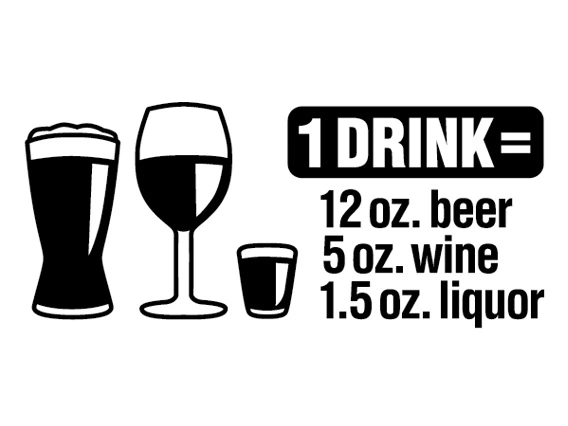Stay In Your Sweet Spot
Need to knows and good to knows for having a good time.

The Sweet Spot
The "sweet spot" of drinking is that balance where you can enjoy the positives of alcohol without the negative aspects most people would rather avoid (getting sick, poor decisions, hangovers, blacking out, regrets, etc.) It's about fully enjoying and remembering your experience while staying safe.
Moderation is the key when it comes to staying in your sweet spot. Moderation can look like choosing certain drinks over others, choosing how many drinks you have in a certain amount of time, making your own drinks, or eating before and during drinking.
Tips to Stay In Your Sweet Spot
Here are some ideas to try. Pick and choose something you'd like to try.
*Sex assigned at birth
Avoid mixing and consuming alcohol in combination with other drugs (prescription and/or recreational substances).
You Can't Manage What You Can't Measure
When you know what you're putting in your body and how much, you set yourself up to have a good, safe time.

What's A Standard Drink?
Not all containers equal one standard drink. Paying attention to the container size and % alcohol can help you in your sweet spot.
Here are general definitions of one standard drink for different types of alcohol:
- Beer/Seltzers: 12 ounces at 5% alcohol
- Wine: 5 ounces at 12% alcohol
- Liquor: 1.5 ounces at 40% alcohol

Standard Drinks in Real Life
| Drink | Alcohol by Volume (ABV) | Ounces (oz) | Standard Drinks |
| Four Loko | 13.9% | 23.5 | 5.5 |
| Beat Box | 11.1% | 16.9oz | 3.1 |
| High Noon | 4.5% | 12oz | 0.90 |
| Twisted Tea | 5% | 12oz | 1.0 |
| Twisted Tea Extreme | 8% | 24oz | 3.2 |
Blood Alcohol Concentration (BAC)
BAC measures how much alcohol is in your bloodstream. It affects things like judgment, coordination, and reaction time.
What Affects BAC?
- Weight: Less weight = higher BAC.
- Sex Assigned At Birth: Women often have higher BAC than men with the same amount of alcohol.
- Time: Faster drinking = quicker BAC rise.
- Amount: More alcohol = higher BAC.
- Food: Drinking on an empty stomach raises BAC faster.
The Impact of BAC
The higher your BAC, the more negative effects you feel and the more dangerous it becomes. Explore and learn how different factors can impact your BAC levels and how long it will take you to get back to a zero with this BAC Calculator*.
*Note: While this calculator mentions use of pain relievers to reduce the effects of hangovers, mixing acetaminophen (Tylenol) with alcohol is dangerous and should be avoided.
What Happens At Different BAC Levels
0.01-0.05%
This is the sweet spot.
Feelings of warmth and relaxation, less cautious, reduced awareness. You can still have impairment in judgment, reaction time, and coordination in your sweet spot.
0.06-0.14%
.08% is considered legally drunk in Arizona.
Arizona is zero tolerance state-you can still be arrested driving with a lower BAC.
Impaired motor skills, dizziness, speech slurring, emotional swings, impaired reasoning, memory, and judgment.
.15-.4%
Above a 0.25%+ BAC can have life-threatening effects.
0.15-0.19%: Nausea and vomiting, inability to walk or stand without assistance, severe confusion, black outs.
0.2-0.4%: Loss of consciousness, respiratory, and cardiac distress.

Alcohol Poisoning
More alcohol in a shorter amount of time leads to higher BAC. This can be dangerous because alcohol is a depressant, which means it depresses your body's involuntary actions - breathing, heartbeat, and gag reflex. When your BAC gets too high, you can have alcohol poisoning, which can lead to death.
The Signs of Alcohol Poisoning
Knowing the signs of alcohol poisoning, can help you save a life. Here's what to look for:
C – Cold or Clammy Skin
U – Unresponsive
P – Puking
S – Slow Breathing
When you see someone showing any or all of these signs, check in with them and don't leave them alone. If someone is passed out, try to wake them up. If they're unresponsive, they need medical attention and follow these 3 steps:
1. Call 911!
2. Put the person on their side in recovery position.
3. Stay until help arrives.
Curious About Your Drinking?
If you're concerned, unsure, or just curious about your drinking patterns, this short screening can give you valuable insights.
